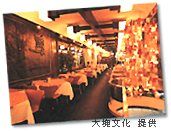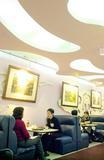Old City of Taipei
1. An 1948 aerial photo taken above the area where Vincent grew
up (大稻埕 1948 年
高空照圖)
Identifications of well-known spots are marked.
2. Few photos taken in old Taipei street corners. 1943,
1962 (pictures provided by T.C. Lee)
3. Nan
Hsin Tea Company 南興茶行 (past
family business)
4. Taipei Maps : set 1- year of 1932
(480K) and
set 2 - year of 2001 (550K)
5. 波麗路 Bolero,
�����q�S�N�x(�F�w���o�L�S�N�x�w���@�ʤ@�Q�~�l�����v
6/03)
6. old �j�_�L
- �ӥ��m
(5/25/03)
走一趟台灣茶街
作者﹕自由時報 記者薛雲峰 (2002)
儘管,新世紀的面貌可能被生物科技或光電科技繪上彩妝,但特有文化與傳統產業的深度結合,仍將是二十一世紀全球重要的經濟發展趨勢與經營策略。畢竟,人離不開土地,更離不開科技以外的生活品味,尤其,台灣在加入世界貿易組織之後,傳統農業在面臨重大衝擊之際;如何讓農產品重回國際舞台,無疑已是台灣當前重要的經濟課題之一。
其中,茶產葉便是台灣所有農產品中,最獨具歷史與文化意涵的一樣。依前清淡水海關紀錄,台灣的出口貿易在一八六八至一八九五年之間,單是茶產業即佔了出口總值的百分之九十。日治第二年,即一八九六年,台茶總共輸出九百六十四萬三千三百七十三公斤,價值五百八十六萬一千一百七十四圓,當年,日本政府編列的台灣年度歲入預算是九百六十五萬圓。
也就是說,光是茶葉的收益,約是全台年度歲入預算的百分之六十。當年風靡全球的出口大宗「Formosa
Oolong Tea」,即是「白毫烏龍」
或別稱「東方美人茶」的椪風茶;這種茶因具有獨步全球的熟果香與蜜香,更是國際市場上量少價昂的搶手貨。簡言之,台茶自十九世紀開始,即對台灣的經濟社會造成鉅大影響,台灣人民的生活水平,也普遍較大陸原鄉地區高出許多的變化;當時,台茶的產銷體系不但啟動了台灣新的權勢階層興起,更是奠下往後台灣快步朝向初級工業化的基礎。
茶街自成區塊
十九世紀末、廿世紀初的國際貿易舞台上,台茶獨步全球的丰采,自然也對台灣的都市化發展產生重大影響,其中最令人側目的便是造就了大稻埕的「台灣茶街」。茶街的範圍大致在現今台北市大同區,從西邊淡水河畔的環河北路算起,東到重慶北路,北至民權西路,往南延伸到長安西路之間;其間又以貴德街為主軸,向四周輻射狀發展,較大的範圍涵蓋現今的民生西路、南京西路、西寧北路、迪化街到延平北路一帶,日本人稱呼這一帶叫做「Daitotai」。
日治中期,美國茶業專家威廉烏克斯(Willam
H. Ukers)來台考察台茶的產銷體系、製茶工法與交易手法時,曾對當時的大稻埕有以下的描述,他說:「茶棧裡,僱有許多從事茶葉分類和炭焙的女工,她們常常是濃妝艷抹的去上工,有著烏黑亮麗的頭髮,髮上喜歡插著茉莉,豐腴的臉頰與烏溜溜的眼神,常透著誘人的氣息,走起路來像是搖曳生姿的百合」
當時的大稻埕,可說是國際級的都市中心,騷人墨客如今走過貴德街殘留斑駁的巴洛克式建築騎樓下,不免也要緬懷這段獨具文化魅力的茶街滄桑。茶街,有著台灣移民史上堅毅的創業精神,也有過蜚譽全球的國際尊榮;若能在新世紀裡結合新興的消費趨勢;那麼,雋永的茶香,或能重啟老街的文化商機。
記憶拼圖
唐山過台灣的移民情懷,仍具體呈現在王錦珍茶行、安西福記茗茶等,由福建安溪後裔開設的茶行裡;日治初期,
貴德街上南興茶行的後門,曾是日治時期台灣文化協會舉行「港町文化講座」(note:
Vincent's father was a member of the group)
的地點之一,那是台灣民族運動的紀念碑,如今或統或獨的爭議,在當時,都只在陣陣茶香裡,化為今日台灣史上一絲絲的氣慨幽魂。茶街上人來人往的「亭仔腳」(騎樓),曾是日治時期總督府執行都市計畫下的一環,曾經在「亭仔腳」下揀茶的女工,也反映了茶產業的獨特生態,例如當年商家不顧規定,佔用「亭仔腳」僱工揀茶的特權。
�@「特權」,是一個弔詭的字眼,有時它被形容像是洪水猛獸,但大多時候,它卻是傳統社會階層向上流動的一個重要指標。以茶產業來說,洋商買辦出身的李春生就是一個令人羡慕的例子,他因為精通英文成為洋商買辦,再利用時局動盪及本身的經營理念,拿下有別於洋商的「台茶之父」稱號;他在擁有大量資本之際恰逢前清政府割讓台灣,當時為了避免台北城暴動擴大,他曾與辜顯榮等人迎接日軍進城,台灣史上因此對他的褒貶不一。
但李春生篤信基督教也是個思想家,他曾獨資興建位於今日台北市甘州街上的禮拜堂;紅磚色的外牆與巴洛克式的造型,曾展現他對西方現代化的想望。這種想望,算得上是台灣全球化的先驅:一種來自國際貿易的經驗,與不願故步自封的思想跳躍。
從前清到日治,台茶創造出的附加價值,除了出現豪宅建築之外,資本階級所引動的文化活動亦豐富了茶街的人文色彩。台灣第一位專業人體模特兒林絲緞,曾在今貴德街與南京西路交叉口附近的一家畫室工作;台灣新文學運動創始人張我軍,曾在貴德街上的農林公司舊址上班;西寧北路不起眼的小巷子裡,留下〈望春風〉〈四季紅〉等名曲的作詞家李臨秋身影。李臨秋故居的附近,曾有一家「宏濟醫院」,院長林清月在看病時不忘研究台灣歌謠,自稱「凡歌必記」,後來「棄醫從歌」進入唱片公司任職,人稱「歌人醫師」。
此外,日治時期出現的台灣人休閒勝地第一劇場�X「永樂座」,亦與台茶貿易有關,因為永樂座的出資興建者陳天來,就是買賣台茶致富,李臨秋年輕時也曾在永樂座上班。至今,貴德街上仍矗立著一座高聳的巴洛克式建築,那就是茶商陳天來的茶行舊址與故居,豪宅內的裝潢考究,室外屋頂鑲嵌著家徽,家徽的磁磚從荷蘭進口,家具是由高級的酸枝、紅檜及黑檀木製成;後來的台灣電影《長江一號》,即曾借用這棟豪宅當場景,將鑲有彩繪玻璃的樓梯全入了鏡。換個角度看來,台茶,正是台灣文化的推手。
社會階級
當然,茶街上不只有富商豪宅,常民生活的文化資產也是處處可見,例如茶街上的慈聖宮、法主宮和城隍廟,至今仍是常民生活的一部分。有趣的是,這些神只的出現,也是來自茶業的商業機制�X「茶郊」;茶郊,是茶商的貿易組織,也是茶商們聚會的所在,茶商們原來在茶郊裡供奉的家鄉守護神,逐漸就演變成大稻埕的地方性宗教盛會,至今成了活生生的文化資產。當然,茶產業帶動經濟繁興,無可避免的也孕育出新的資產階級,也就是說,茶街上的茶行,不只是工作的空間,更是身份地位與摩登時尚的表徵。
除了大茶商李春生蓋在迪化街及甘州街的舊宅,以及陳天來的劇場及巴洛克豪宅之外;至今淡水河落日仍映照的「鹽館」,更是台灣早期接觸西化的代表作之一。「鹽館」,是辜顯榮的故居,一棟二層樓的建築物上。自一樓到二樓的拱形窗與牆壁上,都鑲嵌著獨特的瓷磚圖案。現在,這間宅邸是「榮星幼稚園」的現址;早期,是曾經聞名全台的榮星兒童合唱團的據點。
「榮星」取自辜顯榮的字─「耀星」的「星」與本名中的「榮」,辜家曾在民權東路經營的「榮星花園」〈現已闢為市立公園〉,過去也曾是台北市聞名的景點;流轉在茶街建築物中的社會階級與現代主義特徵,證實了西方價值嵌入台灣市井的年代,可能要比當代人所了解的情況,至少早了七、八十年。
滿足文化慾望
後現代消費主義強調特殊類型與認同的休閒,以及城鄉空間中引人欲求的「文化慾望」。烏爾瑞(Urry,1995)描述了城鎮地景的三個文化吸引力(desirability):一是有可參訪的場所和風景,二是具有合宜美學的鄉土建築,三是休閒活動的文化正當性,例如運用文學和藝術人物,讓某些鄉間具有特殊風味。而「台灣茶街」滿足了這樣的文化慾望;這慾望,構築於當時的空間場域與社會階級,如今,它也是都心的建築座標且具有獨特的文化意涵。其中,值得後現代消費者細細品賞的是,空間場域不只是單純地解構建築形式;更多的是從社會轉化的角度,來考量都市結構變遷的歷史。
著有《台灣茶街》一書的池宗憲認為,把大稻埕放進台北都會區的發展脈絡中,就不難發現它已超越了建築造型分析的限制,也處處透著自前清伊始,大稻埕淡水河岸隱含的社會情境變化,以及空間結構的歷史軌跡。他說,時間與空間的平行與交錯,體現在茶街上的痕跡,至少有因大清朝五口通商條約,進駐福爾摩莎島的外商德記洋行和怡和洋行,這兩座代表當年台茶全盛貿易的德記大樓和怡和大廈中,至今還留有台農與洋商之間,磨合折衝的記憶。
Related topics
History of Tea: http://www.rdandt.com/HISTORY/HISTORY.HTM
Tea Facts: http://www.mycupoftea.com/teafacts.htm
波麗路
(from Sinorama magazine)
《波麗露》是法國作曲家拉威爾一九二八年完成的管弦舞曲,這是一首旋律優美,節奏明快,至今傳奏不輟的樂曲。就在《波麗露》完成六年,也就是一九三四、民國二十三年,有一位原在餐廳擔任大廚工作的廖水來,因為喜愛音樂,就在當時繁華的大稻埕,位在台北市民生西路與延平北路交叉口,開設了一家名叫「波麗路」的西餐廳。為了不辜負《波麗露》這首名曲,廖水來還專程到國外,不惜重金購買一流的進口音響,使「波麗路」的格調更形高雅,吸引許多社會名流在此聚會,附近還有一家著名的「三水亭」中餐店,但生意不及「波麗路」。台灣光復後,「波麗路」已成為文人聚會的地方,李天祿、古龍、詹天馬、周添旺、鄧雨賢等音樂、藝文界人士都常在那裡約會,談文學、談繪畫、談音樂。
從一九三四年至今,「波麗路」已經歷了六十八個寒暑。當年以法式餐點如法國鴨子飯及精緻的西點、咖啡聞名,到今天依然維持這項風格,所不同的是,「波麗路」由原來的一間店,擴張成兩家店。老主人去世後,把產業分給兩個兒子,每個兒子各得一間「波麗路」。其中打著「波麗路本店」的西餐廳給了大兒子,位在「波麗路本店」隔壁的「波麗路」給了二兒子,初次來此用餐的客人常分不清楚兩家有何不同,老顧客可是一清二楚。
在「波麗路」工作三十五年,從小弟爬到總經理的廖聰麒表示,廖水來創辦人是一位白手起家,很有生意頭腦的人,除了把餐廳裝點得美侖美奐,讓老顧客一再回籠外,他還一度把名牌音響擺在店門口,讓路過的人聽到悠揚音樂、看到豪華音響,此舉果然吸引川流不息的人潮,經常要排隊等座位。
廖聰麒說,當時大稻埕是台北市最熱鬧的地方,除文人雅士相約在「波麗路」聚會外,許多生意人也選擇這裡談生意,王永慶就曾來過好多次。另外,「波麗路」的浪漫情調特別適合相親;一對對的情侶在這裡許下他們的海誓山盟,而數十年後,他們的子女也來這裡相親,傳下不少佳話。
Bolero
"Bolero" is a symphonic dance written by the French composer
Maurice Ravel in 1928. It features a wonderful melody as well as a lively tempo,
and to this day remains a musical favorite. In 1934, Liao Shui-lai, a chef and
ardent music lover, opened up a Western-style restaurant with the same name. It
was located in thriving Tataocheng, on the corner of Taipei's Minsheng West Road
and Yenping North Road. In order to fully live up to the name
"Bolero," Liao even made a special trip to Europe, where he spared no
expense to buy a top-of-the line sound system. This added a touch of refinement
to Bolero and turned it into a gathering place for the elite. Close by was the
famous "Three Waters Pavilion" Chinese restaurant, but it was not as
popular as Bolero.
By the end of the era of Japanese occupation, Bolero had become a favored
meeting place for the literati. Musicians and artists such as Li Tien-lu, Ku
Lung, Chan Tien-ma, Chou Tien-wang and Teng Yu-hsin often gathered there to talk
about literature, painting, music. . . .
Since 1934, Bolero has weathered 68 years of business. While Bolero carries
on its legacy of fine French cuisine-such as its French duck-as well as its
coffee, it has expanded to a second location. When its original proprietor died,
he passed on management to his two sons, each of whom inherited one of the
Boleros. The "original Bolero" went to the eldest son, while the
neighboring Bolero went to the second son. Though first-time visitors may
confuse the two locales, regulars are crystal-clear about the differences
between the two.
Liao Tsung-chi, a 35-year veteran of Bolero who has gone from busboy to
general manager, told us that Liao Shui-lai, who created the establishment from
the ground up, was a shrewd businessman. Aside from lavishly outfitting his
restaurant and creating a place for regulars to "recycle" their way
through, he knew how to attract a crowd by positioning his high-end sound system
at the front door so that passers-by could catch strains of its beautiful music
and admire it. As a result, the place would get so crowded that people had to
wait in line for seats.
According to Liao Tsung-chi, Tataocheng was Taipei's trendiest neighborhood
at the time and so, aside from the literati and cultured folk who gathered at
Bolero, many businessmen also made it their choice as the place to talk business
deals. Wang Yung-ching, for one, was a repeat visitor. On top of that, Bolero's
romantic ambience made it particularly well suited for matchmaking. Indeed,
restaurant lore tells of couple after couple sealing lifelong pledges of love
there and, decades later, bringing their own children to do the same.
���[���s���i�R��
(added 5/23/03)
alluring old bistro: perhaps your parents had dated here
�x�_���ܤ]�����ܪ������C�ܪ��������ӪT�|�A���ܪ������ֱo�i���C�M�Ӧ�b���ͦ���W���i�R���\�U�A�N�O�ּƸg���X�Q�~�l�פ��ܪ�����S�ҡC
�p�G���u�ܡv�N�����O�u�P�ɭѶi�B���H�y��}�B�v���ܡA�b�o�h�N�q�U���u�ܡv�q�`�O�n���F�n�O�u���ܡv�N�����O�u�����߳��B�����ǤH�Ұʡv�A�p�����u���ܡv���Ӥ]�ȱo���y�~��C���L�b�ڭ̳o�y�D�ܭY���B����ɥ����ĤT�@�ɫ����A�֦��H�ɦb�ܪ��ƪ��@�I�]�����Hı�o�_�ǡA��s�b���ܪ��ƪ��ϦӤޤH���ءC
�ܦ��i��O�A��b���ͦ�����i�R���\�U�A�N�O�x�_�����Ƥ��h�B�Ƥ@�ƤG���������g��ƪ��䤤���@�C
 �i�R���\�U�b1934�~�}�l��~�A�Z���W�L���Q�~�C���~���O�Ĥ@�a��ƨF�o�ȡB�Ĥ@�a�Q�i�f�Ͽj�B�Ĥ@�a�˦Q���N��B�Ĥ@�a�{�j���ʸm���ɶi�f���T�]�ƪ����\�U�C�]�N�O���A�H�e���O���a���ɰ��ؤ���ƪ����\���ҡA�h���O���U�ȷQ���M���O�ҿת��v�Q���šC
�i�R���\�U�b1934�~�}�l��~�A�Z���W�L���Q�~�C���~���O�Ĥ@�a��ƨF�o�ȡB�Ĥ@�a�Q�i�f�Ͽj�B�Ĥ@�a�˦Q���N��B�Ĥ@�a�{�j���ʸm���ɶi�f���T�]�ƪ����\�U�C�]�N�O���A�H�e���O���a���ɰ��ؤ���ƪ����\���ҡA�h���O���U�ȷQ���M���O�ҿת��v�Q���šC
�P�ɡA�i�R���]�O�q�e�x�_���N�a��H���E�|�Ҧb�C���b�w��W����ꤣ�u�O���D�n����Ӥw�A�ӥB�٪��D��e�a�C���s�ӧ@�Ǥ��]�p�C�۸���o�y�����\�h�ɻ쩱�a�u�g�ͤ릺�v���ͩR�P��ӧ�h�����C�]���F�H�ɭn���ҥH�{�b�h�b�Τ�O�j���^�A����X�i�R���Ǥ����C���]�p�\�O�C����̳ܳ�ª��ʽu�W���A���Τ����N���ا��A�]�S�����s���O���A�ߤ@���˹��N�O��W�������A�o���N�O��ı���I�Ҧb�C�Τ���B���d�M�Z�Z�۫��K�X�ӴI�ܤƪ��X�A�ݰ_��²��A���O�S���`�p���y����O�ι�������_�X�F�ѡA�ڥ��]�p���X�ӡC
�i�R���N�s�\��]��²��o�n�R�C�N���Ѥ@���H����ƭ���A���D��b�ӭ@�[�C�ä��O���Ѫ��F��B���ܪ��ƪ��N�@�w�n�A���b�i�R���A�\�h�ƪ��V�O�g�L�ɶ��~§�A�V����X�����@�H�M���C
�{�b�ڭ̥h���ͦ���|�ݨ��a�i�R���A�@�a�O�ѩ��A�@�a�O�s���C�ܩ���@�a�O�ѩ����@�a�O�s���A���w�g�����n�C�u�n���i�����W�B�����X�G���ѨF�o�A�Y�@�ȡu�ϥλŦ��p�ǥͮɥN�~�|���������ꫬ�K�����v���˪��k���n�l���A�N�ۼƤQ�~�p�@�骺�Ѹ��C�Y�@�y�A�o�˪��ơA�N�����ݩ�@�ظg��C
�ѥx�_���|�t�a�i�R���\�U
���C���v�ؿv
������
8/29/05
�@�x�_�����ͦ���u�i�R���v���\�U�A���ȬO�ѥx�_�H�^�Ъ����|�t�a�A�P�ɲֿn�O���x�W�ɩ|���ǡF�_����Ƨ����ѫ��X�A�g�|�P���M�a�|��Ų�w�A�i�R����~���n��h�ӡA�j������T���~�N�g�筷��A�Ƴs��ⳣ�٫O���L�h�S��A��ij�n���_�����v�ؿv�A�N�e���F�|ij�Q�סC
�@����N�ǰ|�ؿv�Ǫ̧��V�����X�A�i�R������]�p�ĥέ�i�x�W���m�����J�O�˹��A�ѩ��\�U�Ĥ@�N�g��̻ŷR�_�ۡA�C���s�H�饻�_��q�R�@���Ŷ������W���u�u�K���Ӷ��v���]�p�D�D�A�ĥζ¥��^�O���T���ɧJ�B�J���J�f�N�H�A�p���O�����_���C
�@���V�����ܡA�i�R���{�Y���N�@�~�����A��h�ӳ]�p���P���ҡA�@�Ӥ����y�ȡA�G�ӭ������A�ѩ���ɥ����Q���Ȧ�A���ҳ]�p�G�M�j���w��F�Щ�����C�b�~���C�]�p�����X�s�A�ֿn�����x�W�ɩ|���ǡC
�@���M�a�C�p�ءB�����ԡB���I�T�B�̴_��B�i�X��Ų�w�@�ѻ{���A�i�R���ѫe���e�a�C���s�t�d�Ǥ��]�p�A���٤j�_�L�Ĥ@���H�{�N���N�������Ǥ��]�p�����\�U�C
�@�e�a�C���s�H�W�r�u���v�o�Q�A�ˤ�ø�s���m��Z�A�˹��Ѫ�O�M�𭱪d��F��Ƨ����ܡA�ثe�K�Q�h�����b���C���s�ᬰ�ۻ��A�h�~�����|��ӤH�e�i�A���}�i�ܤ�Z�C
�@��Ƨ����A�i�R���Хߥ���G�Q�T�~�A�IJ{�N�D�q��k�˹��A�Ǥ��ĥζi�f���T�����v���֡A�T���~�N�l�ޤj�_�L��H���h�E�|�A�]�A�x�y�q���Ч@�e���H�B��B�P�K���������O�`�ȡF���ɤj�_�L�E�جv��ơA�i�R�����ٷ��a���Ŧ��\�U�A�H�k���p���M�{�N���C�D�W�A�]���A�]�����Q���|�t�a�C
�@
Bolero restaurant has history
on the menu
TASTE OF THE PAST: Established
in 1934, the restaurant reflects a more glamorous era, but has nothing to
attract today's trendy young crowd
By Debby Wu STAFF
REPORTER Tuesday, Jan 27, 2004, Page 4
�@
|

|
Diners
can experience the glamor of a bygone era at the famous Bolero
restaurant, which was established in 1934.
PHOTO: CHIANG YING-YING, TAIPEI TIMES
|
Near the intersection of Taipei's Yenping North Road and
Minsheng West Road, Bolero restaurant is a reflection of the once-vibrant
Tataocheng (
�j�_�L
) area.
Bolero enjoys a huge reputation; when Taipei residents are
asked about the restaurant, most have heard of it and some remember it as a
matchmaking hub.
But like the character Norma Desmond in Sunset
Boulevard, Bolero and Tataocheng's heydays have passed.
The Bolero restaurant opened in 1934, and it was the top
western-style diner in the 1950s and 1960s. But no one would recommend it as a
top-class place to go anymore, although the restaurant still does good business.
"Twenty-five years ago, Bolero was still the leading
restaurant in Taipei, doing even better than five-star hotels. There was no
competition," restaurant manager Liao Tsung-chi (���o�Q),
who has worked there since 1967, said proudly.
"Bolero was not a restaurant for ordinary folks
because of the prices, and people who came were always well-dressed and talked
in low voices. Restaurants in major hotels would also send their people to us to
learn about the business," he said.
Liao said that the restaurant used to host top
businessmen, such as Formosa Plastics Group chairman Wang Yung-ching (���üy).
"He doesn't come here anymore since it's difficult
for a famous person to show up in a public place and not be recognized and
bothered by others. But his third wife still dines here every now and
then," Liao said.
Shipping tycoon Chang Yung-fa (
�i�a�o
) and Lin Yuan Group (
�M����~
) head Tsai Wan-lin (
���U�M
) also used to be Bolero patrons.
Even the so-called tang wai ("outside the
party,"
�ҥ~
) members liked to go there.
Liao said that Huang Hsin-chieh (
���H��
) used to dine there when he was just a junior member of the tang
wai, long before he became chairman of Democratic Progressive Party.
"But of course these days young people have other
choices, and the restaurant has become more a place for reminiscing," Liao
said.
Indeed, with its slightly weathered exterior, plain
white-and-blue billboard and unstylish blue sofa, Bolero has no visible glam to
attract the young anymore.
Liao said that the restaurant now mostly hosts regular
customers, and these customers often bring their relations.
"Now whenever I go to the restaurant, it's more for a
taste of the past," said Yiu Chi-cheng (
��Ӹ�
), a Bolero patron of 30 years.
Originally there was only one Bolero, but founder Liao
Shui-lai (
������
) later split the restaurant into two for his two sons. The
two Boleros are only a few meters away from each other on the same side of the
street.
"But both Boleros are well-known restaurants and
popular matchmaking places," Yiu said.
And it is not just the restaurant that has a long history,
its employees do too. Liao has worked there for more than 30 years, and
25-year-old waiter Lin Po-chi (
�L�է�
) has worked there for 10 years.
"Business is not as good as before with the economy
slowing in recent years," Lin said.
Liao said that his experience in the restaurant proved to
him the validity of the Taiwanese proverb, "Wealth can last no more than
three generations."
"Sometimes I would see that certain customers or
their descendents stop coming because they cannot afford to dine here
any-more," Liao said.
Buildings similar to the one Bolero occupies are
everywhere in the area of Tihua Street, made famous for its candies, snacks and
food for the Lunar New Year holidays.
Most buildings are only three or four floors high, and the
color of red bricks has faded, the white walls grayed.
Yet many buildings are also adorned with delicate
engravings that cannot be seen on more modern constructions.
Tihua Street and Yenping North Road are a part of
Tataocheng, a huge area along Tamshui River to the northwest of Taipei Main
Station.
Tataocheng used to be Taipei's economic center before
Japan's defeat in World War II, but now it is considered part of old Taipei.
Many famous local entrepre-neurs based their businesses in
that area. Both Straits Exchange Foundation Chairman Koo Chen-fu's (�d���j)
father, Koo Hsien-jung (�d��a), and Shinkong (�s��)
Group founder Wu Ho-shih (�d����) were respected
tea merchants, while China Development chairwoman Diana Chen's (������)
family was in the textile business in the area.
"Tataocheng is a noble part of the past," said
Tu Nien-ru (�����|), a 30-year-old Taipei resident.
"But then again, Tihua Street is probably the only place in Taipei that can
allow people to celebrate the Lunar New Year properly with its New Year goodies.
"The glory may be gone, but the area is a cultural
treasure," Tu said.
"When you walk around that area, you do get the
feeling of a rich tradition," he said.
--end of Taipei
Times story------
"���W�ݨ�@�h�����u�i�R�S�v�����ɡA���K�ߦ��ҷP�C�o�a���\�U���g�O�\�h�ѥx�_�H�]�]�A40�h�~�e���کM20�~�e�ڪ��Ĥl�^��զ��\�B�}�v�����a��C���~�A���٬O�j�a�L�ͤ�B�ۿ�
�K���̨γ��ҡC��ӡA�]���������v�����V�Ŷ����B���s�_���A�u�Ѥj���v�B�u���ӷG�v���~�U�_�A�~�ϳo�a�ѩ��ͩ�S���C���O���ޥx�_�����ܡA��ڭ̳o�@�����H�A�߸̦��G�û��s���o�ӡu�ѥx�_�̨嶮���ڦ��\�U�v�A�@�ӥi�H�q�h�¤驹�ƪ��v���C"
-
a note from Felix Wang who provides the link to the Taipei Times story 1.27.04
�@
�@
 �i�R���\�U�b1934�~�}�l��~�A�Z���W�L���Q�~�C���~���O�Ĥ@�a��ƨF�o�ȡB�Ĥ@�a�Q�i�f�Ͽj�B�Ĥ@�a�˦Q���N��B�Ĥ@�a�{�j���ʸm���ɶi�f���T�]�ƪ����\�U�C�]�N�O���A�H�e���O���a���ɰ��ؤ���ƪ����\���ҡA�h���O���U�ȷQ���M���O�ҿת��v�Q���šC
�i�R���\�U�b1934�~�}�l��~�A�Z���W�L���Q�~�C���~���O�Ĥ@�a��ƨF�o�ȡB�Ĥ@�a�Q�i�f�Ͽj�B�Ĥ@�a�˦Q���N��B�Ĥ@�a�{�j���ʸm���ɶi�f���T�]�ƪ����\�U�C�]�N�O���A�H�e���O���a���ɰ��ؤ���ƪ����\���ҡA�h���O���U�ȷQ���M���O�ҿת��v�Q���šC